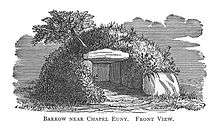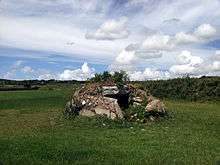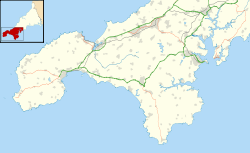Brane Barrow
Brane Barrow, also known as Chapel Euny Barrow or Hut Barrow, is a Neolithic chambered round barrow, near the hamlet of Brane, Cornwall (grid reference SW401282).[1] It is located two miles southwest of Sancreed.

| Brane Barrow | |
|---|---|
 | |
| Location | Cornwall |
| Coordinates | 50.0968°N 5.6350°W |
 Location of Brane Barrow in Southwest Cornwall | |
The chamber has a height of 0.9 metres, a width of 1.2 metres and a length of 2.3 metres. The surrounding mound measures 6.1 metres diameter by 2.1 metres high. The only mutilation is on the south where the side of the barrow has been removed to expose the chamber.[2] The barrow was described by William Copeland Borlase in 1872 and is in much the same condition as when he saw it.[2]
The barrow is considered to be an example of the Scillonian Group of chambered round barrows, of which there are over forty in the Scilly Isles, and four in west Cornwall.[3] The barrow can be visited with permission at Brane farm.[4]
References
- Pevsner, Nikolaus (1977). Cornwall (The Buildings of England). Pevsner Architectural Guides. p. 207. ISBN 0140710019.
- HUT BARROW, Pastscape, retrieved 21 May 2013
- L. V. Grinsell, (1936), The Ancient Burial-mounds of England, page 123. Taylor & Francis
- Julian Cope (1998). The Modern Antiquarian: A Pre-millennial Odyssey Through Megalithic Britain : Including a Gazetteer to Over 300 Prehistoric Sites. Thorsons Pub. p. 157. ISBN 978-0-7225-3599-8.
External links
- "Brane: Entrance Grave; Cornwall". Megaliths.com. Retrieved 11 April 2013.